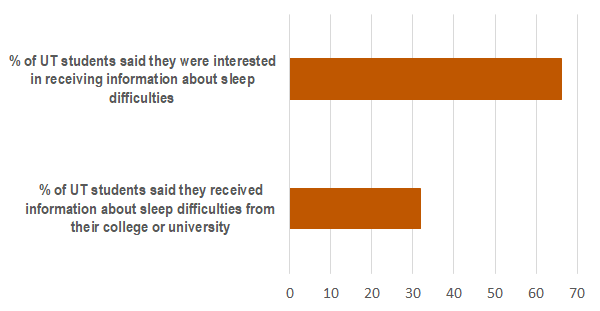UT Austin students, like many students across the country, are not getting enough sleep. Roughly 74 percent of UT Austin students reported feeling sleepy or tired for three to seven of the past seven days. Students rank sleep difficulties (21.6 percent) only behind stress (39.4 percent) and anxiety (27.3 percent) when asked about the impacts to their academic performance (American College Health Association-National College Health Assessment, 2019).
In one study, 82 percent of college students believe that inadequate sleep and sleepiness impact their school performance (Hershner & Chervin, 2014), and research supports their claims. Insufficient sleep has been linked to decreased memory consolidation, learning, decision making, critical thinking and a greater frequency of stress (Batterink, Westerberg, & Paller, 2017; Lemma et al., 2014; Dusselier et al., 2005).
Sleep plays a bigger role in GPA than most would assume. Students who get seven to nine hours of sleep had higher grade point averages than students who did not get that much sleep regularly (Yu & Arendt, 2017). Sleep habits, in particular weekday and weekend wake up times, had the greatest effect on GPA, even greater than other variables including eating breakfast, exercise, gender and age (Trockel, Barnes, & Egget, 2000).

Data shows that UT students want resources about how to get a better night’s sleep. The chart above illustrates the discrepancy that currently exists between students who have received information about sleep difficulties (about 33 percent) and those who are interested in receiving more information (about 66 percent) (American College Health Association-National College Health Assessment, 2017).
Faculty can play an active role in encouraging healthy sleep habits in students. The following examples show how you can promote good sleep habits among your students.
In your syllabus and Canvas page
Assigments
In class

References
American College Health Association. (2017). American College Health Association-National College Health Assessment II: University of Texas at Austin Institutional Data Report Spring 2017. Hanover, MD: American College Health Association.
American College Health Association. (2019). American College Health Association-National College Health Assessment II: University of Texas at Austin Institutional Data Report Fall 2019. Hanover, MD: American College Health Association.
Batterink, L. J., Westerberg, C. E., & Paller K. A. (2017). Vocabulary learning benefits from REM after slow-wave sleep. Neurobiology of Learning ≈ Memory, 144, 102-113.
Dusselier, L., Dunn, B., Wang, Y., Shelley, M.C. & Whalen D.F. (2005) Personal, Health, Academic, and Environmental Predictors of Stress for Residence Hall Students. Journal of American College Health, 54(1), 15-24.
Hershner, S. D., & Chervin, R. D. (2014). Causes and consequences of sleepiness among college students. Nature and Science of Sleep, 6, 73–84. http://doi.org/10.2147/NSS.S62907
Lemma, S., Berhane, Y., Worku, A., Gelaye, B., & Williams, M. A. (2014). Good Quality Sleep is Associated with Better Academic Performance among University Students in Ethiopia. Sleep & Breathing = Schlaf & Atmung, 18(2), 257–263. http://doi.org/10.1007/s11325-013-0874-8
Trockel, M., Barnes, M., & Egget, D. (2000). Health-related variables and academic performance among first-year college students: Implications for sleep and other behaviors. Journal of American College Health, 49, 125–131.
Yu, C. Arendt, S.W. (2017). Benefits of Sleep for Undergraduate Students’ Academic Performance. Journal of Hospitality & Tourism Education, 29(2). http://dx.doi.org/10.1080/10963758.2017.1297713